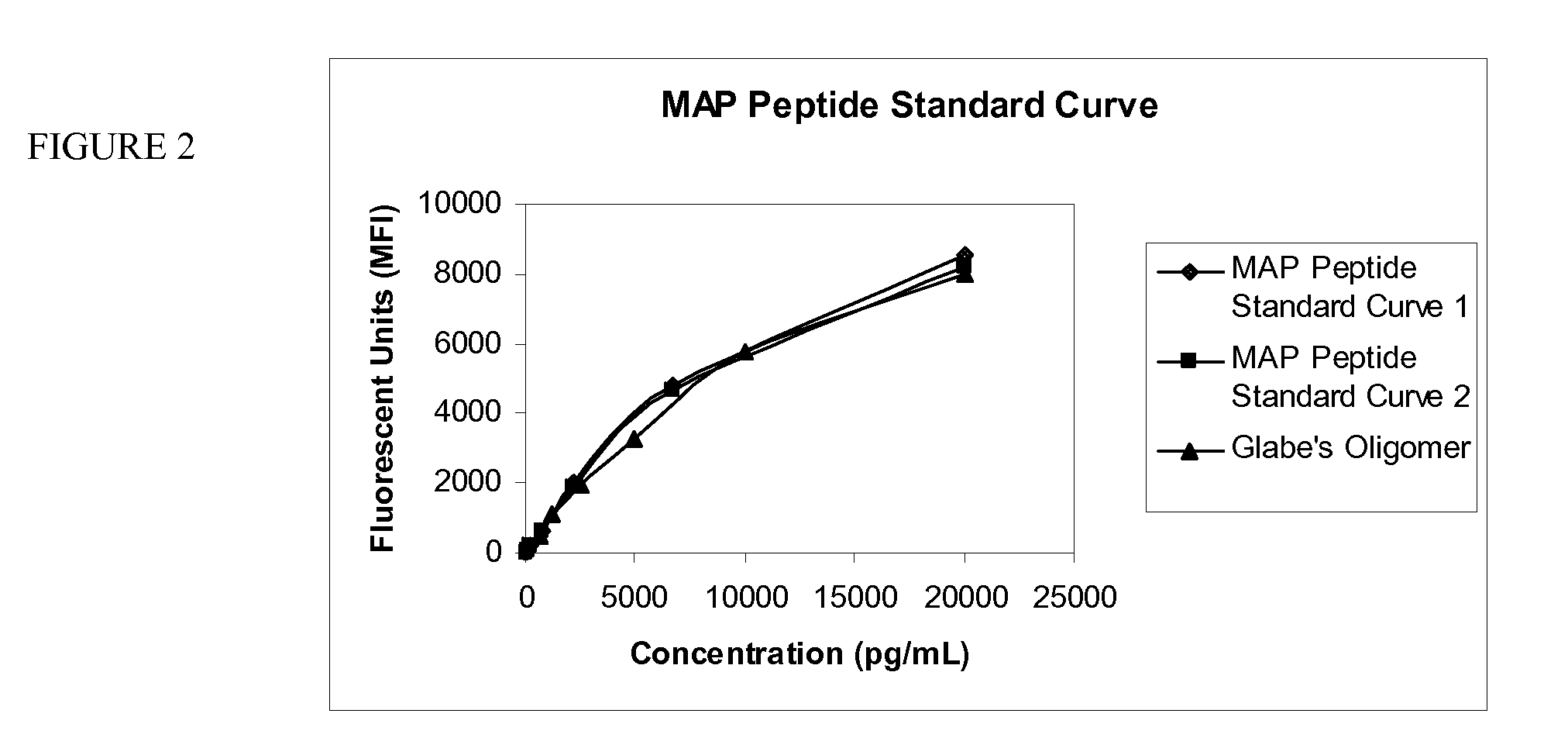Compositions and Methods for Detecting and Quantifying Toxic Substances in Disease States
a technology of toxic substances and compounds, applied in the field of compositions and methods for detecting and quantifying toxic substances in disease states, can solve the problems of complex purification and storage of these components, difficult to obtain pure forms of aggregated peptides to use as standards, and difficult to isolate large quantities of sufficiently purified aggregated peptides to be used as standards in quantitative assays
- Summary
- Abstract
- Description
- Claims
- Application Information
AI Technical Summary
Problems solved by technology
Method used
Image
Examples
example 1
Preparation of a 4-Branched MAP-Aβ1-20
[0091]The MAP-Aβ1-20 peptide was constructed using Fmoc protein synthesis chemistry, which is described in Tam, J. P. and Lu, Y.-A., Proc. Nat'l. Acad. Sci., 85:9084-9088 (1989); Ahlborg, N., J. Immunol. Methods, 179:269-275 (1995); and Espanel, X., et al., J. Biol. Chem. 278(17):15162-15167 (2003), all of which are incorporated by reference in their entirety. The β-alanine was first immobilized, and the lysine residues were added to the immobilized β-alanine Through a series of addition of protected amino acid residues, the chains were elongated in the C to N terminal direction.
example 2
Quantification of Aggregated Aβ1-42 Using MAP-Aβ1-20
[0092]As described in U.S. Pat. Nos. 6,696,304, 6,649,414, 6,632,536 and 6,599,331, which are incorporated by reference, antibody specific for Aβ1-20 was conjugated to color encoded beads, composed of polystyrene, which were licensed from Luminex™ Corporation (Austin, Tex.). Wells of a 96-well plate were pre-wet with 200 μL working buffer / wash solution. The wash solution is available from Biosource International (Camarillo, Calif., USA). After about 15 to 30 seconds, the wash solution was aspirated from the wells using vacuum manifold.
[0093]The bead conjugation method used yields a 100× stock solution, containing approximately 20×106 beads / mL. The beads used in the assay were prepared from the 100× stock solution. Just prior to use, the stock solution was vortexed for 30 seconds, and then sonicated for 30 seconds. The working solution of the conjugated beads, containing about 2×105 beads / mL, was prepared by diluting the stock solu...
example 3
Preparation of a 4-Branched MAP-Alpha-Synuclein
[0108]The MAP-alpha-synuclein 116-130 peptide was constructed using Fmoc protein synthesis chemistry, which is described in Tam, J. P. and Lu, Y.-A., Proc. Nat'l. Acad. Sci., 85:9084-9088 (1989); Ahlborg, N., J. Immunol. Methods, 179:269-275 (1995); and Espanel, X., et al., J. Biol. Chem. 278(17):15162-15167 (2003), all of which are incorporated by reference in their entirety. As used herein, the phrase MAP-alpha-synuclein 116-130 peptide indicates a peptide with amino acids 116-130 of SEQ ID NO:2. Following the same general construction of the 4-branched MAP-Aβ1-20 standard, a β-alanine moiety was first immobilized, and the lysine residues were added to the immobilized β-alanine. Through a series of addition of protected amino acid residues, the chains were elongated in the C to N terminal direction.
PUM
| Property | Measurement | Unit |
|---|---|---|
| concentrations | aaaaa | aaaaa |
| concentration | aaaaa | aaaaa |
| concentration | aaaaa | aaaaa |
Abstract
Description
Claims
Application Information
 Login to View More
Login to View More - R&D
- Intellectual Property
- Life Sciences
- Materials
- Tech Scout
- Unparalleled Data Quality
- Higher Quality Content
- 60% Fewer Hallucinations
Browse by: Latest US Patents, China's latest patents, Technical Efficacy Thesaurus, Application Domain, Technology Topic, Popular Technical Reports.
© 2025 PatSnap. All rights reserved.Legal|Privacy policy|Modern Slavery Act Transparency Statement|Sitemap|About US| Contact US: help@patsnap.com



